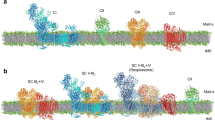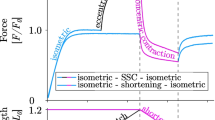Abstract
The molecular mechanisms by which different mutations in actin lead to distinct cardiomyopathies are unknown. Here, actin mutants corresponding to α-cardiac actin mutations causing hypertrophic cardiomyopathy [(HCM) P164A and A331P] and dilated cardiomyopathy [(DCM) R312H and E361G] were expressed in yeast and purified for in vitro functional studies. While P164A appeared unaltered compared to wild-type (WT) actin, A331P function was impaired. A331P showed reduced stability in circular dichroism melting experiments; its monomer unfolding transition was 10°C lower compared to WT actin. Additionally, in vitro filament formation was hampered, and yeast cell cultures were temperature sensitive, implying perturbations in actin–actin interactions. Filament instability of the A331P mutant actin could lead to actomyosin dysfunction observed in HCM. Yeast strains harboring the R312H mutation did not grow well in culture, suggesting that cell viability is compromised. The E361G substitution is located at an α-actinin binding region where the actin filament is anchored. The mutant actin, though unaltered in the in vitro motility and standard actomyosin functions, had a threefold reduction in α-actinin binding. This could result in impairment of force-transduction in muscle fibers, and a DCM phenotype.
Similar content being viewed by others
References
Blanchard A, Ohanian V and Critchley D (1989) The structure and function of α-actinin. J Muscle Res Cell Motil 10: 280–289.
Bonne G, Carrier L, Richard P, Hainque B and Schwartz K (1998) Familial hypertrophic cardiomyopathy: from mutations to functional defects. Circ Res 83: 580–593.
Cook RK, Blake WT and Rubenstein PA (1992) Removal of the amino-terminal acidic residues of yeast actin. Studies in vitro and in vivo. J Biol Chem 267: 9430–9436.
Doyle TC, Hansen JE and Reisler E (2001) Tryptophan fluorescence of yeast actin resolved via conserved mutations. Biophys J 80: 427–434.
Fatkin D, MacRae C, Sasaki T, Wol. MR, Porcu M, Frenneaux M, Atherton J, Vidaillet Jr, HJ, Spudich S, De Girolami U et al. (1999) Missense mutations in the rod domain of the lamin A/C gene as causes of dilated cardiomyopathy and conduction-system disease. N Engl J Med 341: 1715–1724.
Gerson JH, Bobkova E, Homsher E and Reisler E (1999) Role of residues 311/312 in actin-tropomyosin interaction. J Biol Chem 274: 17,545–17,550.
Godfrey JE and Harrington WF (1970) Self-association in the myosin system at high ionic strength. I. Sensitivity of the interaction to pH and ionic environment. Biochemistry 9: 886–893.
Holmes KC, Popp D, Gebhard W and Kabsch W (1990) Atomic model of the actin filament. Nature 347: 44–49.
Homsher E, Wang F and Sellers JR (1992) Factors affecting movement of F-actin filaments propelled by skeletal muscle heavy meromyosin. Am J Physiol 262: C714–C723.
Hozumi T, Miki M and Higashi-Fujime S (1996) Maleimidobenzoyl actin: its biochemical properties and in vitro motility. J Biochem 119: 151–156.
Ito H, Fukuda Y, Murata K and Kimura A (1983) Transformation of intact yeast cells treated with alkali cations. J Bacteriol 153: 163–168.
Johara M, Toyoshima YY, Ishijima A, Kojima H, Yanagida T and Sutoh K (1993) Charge-reversion mutagenesis of Dictyostelium actin to map the surface recognized by myosin during ATP-driven sliding motion. Proc Nat Acad Sci (USA) 90: 2127–2131.
Kabsch W, Mannherz HG, Suck D, Pai EF and Holmes KC (1990) Atomic structure of the actin: DNase I complex. Nature 347: 37–44.
Kamisago M, Sharma SD, DePalma SR, Solomon S, Sharma P, McDonough B, Smoot L, Mullen MP, Woolf PK, Wigle ED et al. (2000) Mutations in sarcomere protein genes as a cause of dilated cardiomyopathy. N Engl J Med 343: 1688–1696.
Karlsson R, Aspenström P and Byström AS (1991) A chicken β-actin gene can complement a disruption of the S. cerevisiae ACT1 gene. Mol Cell Bio 11: 213–217.
Kim E, Miller CJ and Reisler E (1996) Polymerization and in vitro motility properties of yeast actin: a comparison with rabbit skeletal α-actin. Biochemistry 35: 16,566–16,572.
Kodama T, Fukui K and Kometani K (1986) The initial phosphate burstin ATP hydrolysis by myosin and S1 as studied by a modified malachite green method for determination of Pi. J Biochem 99: 1465–1472.
Kron SJ, Toyoshima YY, Uyeda TQ and Spudich JA (1991) Assays for actin sliding movement over myosin-coated surfaces. Methods Enzym 196: 399–416.
Kuhlman PA, Hemmings L and Critchley DR (1992) The identification and characterisation of an actin-binding site in α-actinin by mutagenesis. Febs Lett 304: 201–206.
Laemmli UK (1970) Cleavage of structural proteins during the assembly of the head of bacteriophage T4. Nature 227: 680–685.
Lebart MC, Méjean C, Boyer M, Roustan C and Benyamin Y (1990) Localization of a new α-actinin binding site in the COOH-terminal part of actin sequence. Biochem Biophys Res Comm 173: 120–126.
Levine BA, Moir AJ, Patchell VB and Perry SV (1992) Binding sites involved in the interaction of actin with the N-terminal region of dystrophin. Febs Lett 298: 44–48.
Li D, Tapscoft T, Gonzalez O, Burch PA, Quiñones MA, Zoghbi WA, Hill R, Bachinski LL, Mann DL and Roberts R (1999) Desmin mutation responsible for idiopathic dilated cardiomyopathy. Circulation 100: 461–464.
Lorenz M, Poole KJ, Popp D, Rosenbaum G and Holmes KC (1995) An atomic model of the unregulated thin filament obtained by X-ray fiber diffraction on oriented actin–tropomyosin gels. J Mol Biol 246: 108–119.
Matsuura Y, Stewart M, Kawamoto M, Kamiya N, Saeki K, Yasunaga T and Wakabayashi T (2000) Structural basis for the higher Ca2+-activation of the regulated actin-activated myosin ATPase observed with Dictyostelium/Tetrahymena actin chimeras. J Mol Biol 296: 579–595.
Miller CJ and Reisler E (1995) Role of charged amino acid pairs in subdomain-1 of actin in interactions with myosin. Biochemistry 34: 2694–2700.
Miller CJ, Doyle TC, Bobkova E, Botstein D and Reisler E (1996) Mutational analysis of the role of hydrophobic residues in the 338–348 helix on actin in actomyosin interactions. Biochemistry 35: 3670–3676.
Mimura N and Asano A (1987) Further characterization of a conserved actin-binding 27-kDa fragment of actinogelin and α-actinins and mapping of their binding sites on the actin molecule by chemical cross-linking. J Biol Chem 262: 4717–4723.
Mogensen J, Klausen IC, Pedersen AK, Egeblad H, Bross P, Kruse TA, Gregersen N, Hansen PS, Baandrup U and Borglum AD (1999) α-cardiac actin is a novel disease gene in familial hypertrophic cardiomyopathy. J Clin Invest 103: R39–R43.
Mossakowska M and Strzelecka-Golaszewska H (1985) Identification of amino acid substitutions differentiating actin isoforms in their interaction with myosin. Eur J Biochem 153: 373–381.
Muntoni F, Cau M, Ganau A, Congiu R, Arvedi G, Mateddu A, Marrosu MG, Cianchetti C, Realdi G, Cao A et al. (1993) Brief report: deletion of the dystrophin muscle-promoter region associated with X-linked dilated cardiomyopathy. N Engl J Med 329: 921–925.
Olson TM, Michels VV, Thibodeau SN, Tai YS and Keating MT (1998) Actin mutations in dilated cardiomyopathy, a heritable form of heart failure. Science 280: 750–752.
Olson TM, Doan TP, Kishimoto NY, Whitby FG, Ackerman MJ and Fananapazir L (2000) Inherited and de novo mutations in the cardiac actin gene cause familial hypertrophic cardiomyopathy. J Mol Cell Cardiol 32: 1687–1694.
Olson TM, Kishimoto NY, Whitby FG and Michels VV (2001) Mutations that alter the surface charge of α-tropomyosin are associated with dilated cardiomyopathy. J Mol Cell Cardiol 33: 723–732.
Rayment I, Holden HM, Whittaker M, Yohn CB, Lorenz M, Holmes KC and Milligan RA (1993) Structure of the actin-myosin complex and its implications for muscle contraction. Science 261: 58–65.
Schutt CE, Myslik JC, Rozycki MD, Goonesekere NC and Lindberg U (1993) The structure of crystalline profilin-β-actin. Nature 365: 810–816.
Sherman F (1991) Getting started with yeast. Methods Enzym 194: 3–21.
Sheterline P, Clayton J and Sparrow J (1995) Actin. Protein Profile 2: 1–103.
Sikorski RS and Hieter P (1989) A system of shuttle vectors and yeast host strains designed for efficient manipulation of DNA in S. cerevisiae. Genetics 122: 19–27.
Spudich JA and Watt S (1971) The regulation of rabbit skeletal muscle contraction. I. Biochemical studies of the interaction of the tropomyosin–troponin complex with actin and the proteolytic fragments of myosin. J Biol Chem 246: 4866–4871.
Sutoh K, Ando M and Toyoshima YY (1991) Site-directed mutations of Dictyostelium actin: disruption of a negative charge cluster at the N terminus. Proc Natl Acad Sci (USA) 88: 7711–7714.
Tsubata S, Bowles KR, Vatta M, Zintz C, Titus J, Muhonen L, Bowles NE and Towbin JA (2000) Mutations in the human δ-sarcoglycan gene in familial hypertrophic cardiomyopathy and sporadic dilated cardiomyopathy. J Clin Invest 106: 655–662.
Volkmann N, Hanein D, Ouyang G, Trybus KM, DeRosier DJ and Lowey S (2000) Evidence for cleft closure in actomyosin upon ADP release. Nat Struct Biol 7: 1147–1155.
Watkins H, Seidman JG and Seidman CE (1995) Familial hypertrophic cardiomyopathy: a genetic model of cardiac hypertrophy. Hum Mol Gen 4: 1721–1727.
Weeds AG and Pope B (1977) Studies on the chymotryptic digestion of myosin. Effects of divalent cations on proteolytic susceptibility. J Mol Biol 111: 129–157.
Wertman KF, Drubin DG and Botstein D (1992) Systematic mutational analysis of the yeast ACT1 gene. Genetics 132: 337–350.
Author information
Authors and Affiliations
Rights and permissions
About this article
Cite this article
Wong, W.W., Doyle, T.C., Cheung, P. et al. Functional studies of yeast actin mutants corresponding to human cardiomyopathy mutations. J Muscle Res Cell Motil 22, 665–674 (2001). https://doi.org/10.1023/A:1016354308436
Issue Date:
DOI: https://doi.org/10.1023/A:1016354308436




